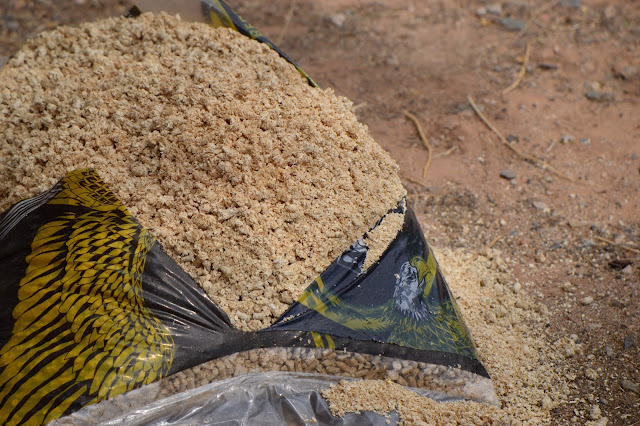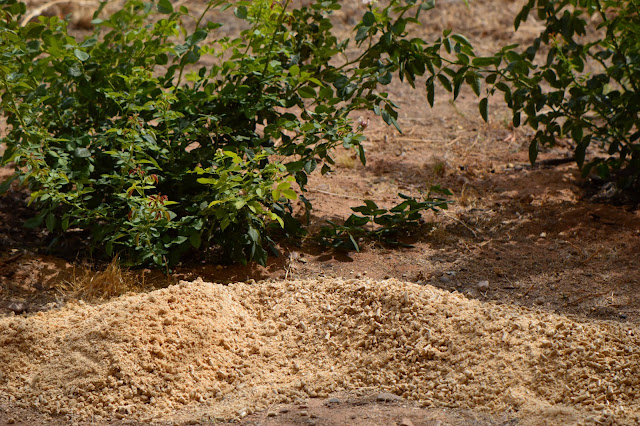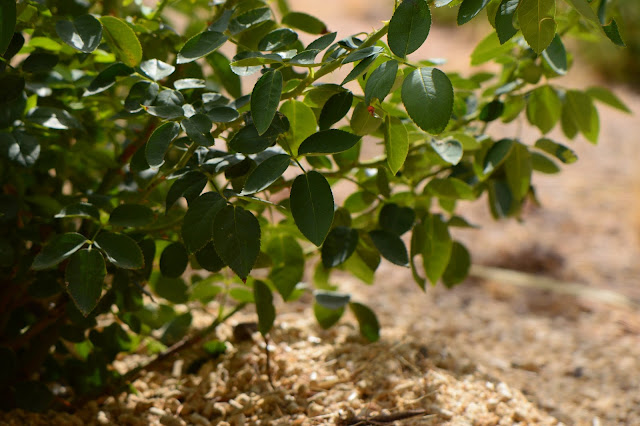To be honest, I was always rather careless about mulch when gardening in the Midwest. My use of it was less than scientific. Now in a region defined by low rainfall and intense heat, I am looking much more closely at the stuff. In fact, I am getting a little creative...
One of the first things I noticed about gardening materials here in the Phoenix, AZ, area was the near-universal use of rock mulch. Crushed rock in various sizes and colours, much of it quite attractive, is the signature local product for landscaping. One can see why. It's much easier to think of rock than of forest products here. But it was confusing to a newcomer. I actually spent a fair amount of time wondering what, if any, were the reasons rock was preferable to organic mulches. Did wood mulch harbour scorpions and other hazardous creatures? Was it somehow bad for plants in an overheated climate? Yes, I have a fairly good imagination! But instinct still told me my gravelly clay soil would be much the better for something that would eventually break down and supply nutrients and conditioning. So I waited for more information.
With the aid of a book or two, I was finally able to verify that organic mulches would be an excellent choice. Also, I finally located the bags tucked back into corners and along far walls at the local GCs. So they did actually sell bark mulch! I bought some handsome red mulch and some less expensive dark brown ditto and began testing them in the garden. This was last spring. Both were acceptable. Here is the dark mulch in need of topping off under a rose bush.
Then temperatures rose. This affected more than the garden. The soil no longer passed the five-second test. This is the rule-of-thumb method for determining whether it is safe to take pets along when walking on hot soil, sidewalk, or whatever else. Place the palm of your hand on the walking surface and hold for a count of five; if it's too hot for your hand, it's too hot for the dog's feet for any extended period...
I decided to test an idea I had been playing with for weeks. This was to repurpose our favourite horse bedding pellets for a walking surface. It worked quite well at keeping the ground surface cool enough to walk on. Soon thereafter, I decided it was time to try them out as garden mulch. It might work; it just might! I tried it. Then I tried it some more. It seems to work. It seems to work well.
As this is not a product that will be familiar to most gardeners, I am going to give a complete description of how I prepare and use it. I'll discuss the successes, pros and cons afterward. Here is where it starts.
There are a number of different brands; I expect the selection is regional to a degree. Eagle Valley is carried by our local farm supply, which is where you will most likely find the product. It is normally sold as bedding for horses and livestock, large and small. Bag size is around 35 lbs., but the product expands considerably in use.
It begins as compressed pellets.
Because of the expansion, I like to cut the bag crosswise from end to end.
Then I pour water gently over the whole surface, trying to get it to all parts of the bag. It should take about 1 gallon (4 litres) to moisten the contents. As the water is applied...
...the pellets slowly begin crumbling into the sawdust they actually are.
They swell clear of the bag...
...creating a nice pile of wood... mulch!
I had only one bag left when I took these pictures today, so this is the contents of one bag. Two would have given better coverage of this area in the Rose Border. But this at least gave a good basic layer when spread with the rake.
Once the area is watered one more time, the mulch will expand just a little more as the remaining intact pellets dissolve. In the meantime, it already serves to protect the soil around the bushes.
Earlier I promised a look at the advantages, disadvantages, and general characteristics of pine pellets used as mulch. I've only been trying them for a little over a month, but here is my current data.First, it is an organic mulch, capable of actually improving the nature of the soil as it breaks down over time.
Second, it is incredibly absorbant. This is what it was designed to do - absorb moisture! I believe that for some plants it will allow me to nearly double my between-watering times. I can put more water on an area to begin with, and the mulch allows it to be released slowly in situ at the plant's roots. In a dry-soil garden this is a great advantage over standard bark mulches, which simply allow the water to filter down through a loose, non-absorbant heap of material.
Thirdly, it keeps the ground surface much cooler. If I place my hand on exposed soil, then on the mulch, the difference is tremendous. I believe this is due to the fine texture of the product. Unlike rock or even bark mulch, there are no broad, flat areas to receive and store sun heat. Instead, there are zillions of grains with air settling between them, forming a good, insulating cover to keep plant roots cooler.
Additionally, it does spread further, making it cost-effective at least with bagged mulch; I don't know how it compares with bulk.
As for disadvantages, most do not apply in this climate. There is an aesthetic question about the very light colouring; I would prefer a darker mulch. But that is a minor disadvantage.
My one ongoing concern is that the material may form a crust if allowed to soak and dry too many times. Only continued use will tell, and I am not sure that it will be very problematic even if this does occur.
Like any wood mulch, it will likely acidify the soil. Desert soil is proverbially alkaline and salty, so this is actually an advantage here, but it might be an issue in an area with higher rainfall or naturally acid soils.
Its absorbancy may damage sensitive plant crowns. As with any mulch, be cautious of smothering roots and crowns. This mulch when applied is nicely aerated, but it will surely settle over time and will need careful usage accordingly. Remember that it holds more water than standard mulches.
These things said, I have not had any negative responses from any of the plants I have been using it with. I began lightly, of course; and I have tried to be careful about the smothering effect as so many of my plants require "well-drained soil" and all the rest of it! But as I have had to learn that instructions "never water" are to be followed at peril of losing the plant, I am getting braver with mulching those "never mulch" plants here. It's just a totally different gardening equation.
In fact, the decisive plant has been an Agastache. A. "Ava", a dry-climate, well-drained soil, rugged western native plant has been nigh unto death time after time since planting. She was planted late because the order arrived late because Salvia reptans (sitting next to her and smiling its way through 110 F) was in the same order and wasn't ready to ship on time. It couldn't be helped. Ava has looked tolerably good only when kept watered twice daily, which is too much for this gardener! Once daily, and I would go out and find her at death's door every morning. It didn't help that I failed to make a large enough watering basin when I planted her, which makes it hard to give a thorough soaking.
So I put my chin up and applied a deep pile of the mulch around Ava. Right up to the stems, which I shall have to keep a close eye on! And she perked up! I actually let her go 48 hours between waterings the other day as the heat was not so bad. This turned out to be a little long, but with water once a day, she is looking quite healthy now. If only she can settle in, she should be her rugged self by next summer.
Mulching Agastache... Today I finally mulched my Perovskia as well. There are a few desert die-hards that I am not trying this on, so far at least. These include Tetraneuris, Penstemon parryi, and Acacia salicina. But even my surviving Osteospermums look better with it. And as you can see, I just began using this mulch on the Rose Border.
So that is my experiment. I'll try to keep the results posted as I continue working with this somewhat unorthodox mulch!
Weather Diary: Fair; High: 102 F (39 C)/Low: 86 F (30 C)














That is a great solution. I have used lucerne pellets before and they were good, I did find they crusted up but it was no problem really. I wonder if you could use coir, do you get the blocks of compressed coir which you add water to? They are dark in colour and also have great water retention properties and may be cheaper, here a block is about $2.50 the size of a brick and expands to a wheelbarrow full.
ReplyDeleteThat sounds great, but I don't think I've seen it available here. Would love to try it as the dark colours are easier on the eyes in strong sunlight... ;-)
DeleteI'll be interested to see how the pellet mulch performs over the summer months, Amy. Are you still using the ollas too? I'm trying a combination of unglazed clay tubes and plastic bottles to slowly release moisture for some of my late plantings but the jury's still out on those.
ReplyDeleteYes, this is definitely a watch and see project, Kris! I'm still using the ollas; they are too small and require frequent refilling, but I think they have helped overall. At any rate, I can say that the plants I used them for are all doing well, but of course I have nothing to compare that with... Come autumn I hope to make some larger ollas, but it's too hot to use the kiln right now :P Looks like ceramics firing will be seasonal out here! I'll be interested to know if the slow release works for your late plantings. It seems like it would be so much more effective.
DeleteThankyou so much for this post - I've never seen this type of product used as mulch before, but I have a really problematic area under several large Eucalypt trees which dries out no matter what I do with it and plants fail to thrive, this might be good for that area.
ReplyDeleteOne thing to check though is what it does to the nitrogen levels around the plants - wood products of any sort deplete nitrogen when they first start to break down - most bark mulches sold already have some degree of decay, so it isn't a massive issue (also as you say, bark mulches are more common in areas which have leaf litter, so soil nitrogen is always being replenished)....if you start to notice the leaves looking a bit yellow then add some blood and bone/bone meal around the plants
Thanks for the advice; I'll definitely watch out for that! Since we used these pellets for horse bedding in Kansas City, they were automatically incorporated into my stable compost, which I sometimes used when planting. In that case, however, the concern was getting too much nitrogen, for obvious reasons ;-) We're just getting our first downpour of the July/August monsoon season (it feels and smells wonderful!) so I will be interested to see how the stuff responds.
Delete